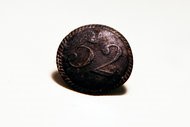David W. Dunlap, New York Times
After a short, hard life on the water — a brutal one, perhaps, transporting slaves or fighting off pirates — the shallow, broad-beamed, 45-foot sloop docked in Lower Manhattan one day in the late 1700s. And stayed there for two more centuries.
Now, the remnants of what is called the “World Trade Center Ship,” because that is where it was excavated five years ago, are destined for a permanent new berth: Albany.

Archaeologists excavating the remnants of an 18th-century ship that were found in 2010 during construction work at the World Trade Center site. Fred R. Conrad, The New York Times
“Albany was a central part of the entire maritime culture of colonial and post-colonial America,” said David Emil, the president of the Lower Manhattan Development Corporation, which is financing the conservation, transportation, documentation and eventual installation of the ship, at the New York State Museum.
“It is totally appropriate to have the ship in a museum in Albany,” Mr. Emil said this week. The Hudson River was a central commercial artery and Albany was a key way station between New York City and the interior United States, especially after the Erie Canal was built.
Albany may even have been a port of call for the World Trade Center Ship. Among the fascinating findings made by expert researchers is that the vessel conforms in key respects to sailing ships called Hudson River sloops, which had “very beamy hulls that placed an emphasis on carrying a large cargo or a great amount of passengers rather than speed,” in the words of a detailed report prepared by the engineering and environmental planning firm AKRF.
Since 2011, the timbers of the World Trade Center Ship have been in a laboratory at Texas A&M University in College Station, which the vessel did not visit in the 1700s.
Much about its transfer to Albany, including the timetable, has yet to be determined, Antonia Valentine, a spokeswoman for the State Museum, said on Friday.
But the development corporation board made the project possible last week by authorizing as much as $1.1 million to further conserve and to exhibit the ship. It has already spent $1 million, so the project would cost a total of $2.1 million.
“The ship reminds us that preservation and progress don’t have to be in conflict, but can complement each other,” Avi Schick, the chairman of the corporation, said.
The ship remnant and 7,500 small objects associated with it remind us of many things.
A pewter button inscribed “52” speaks of the Revolutionary War. It would have originally been worn by a member of the British 52nd Regiment of Foot, which fought the Americans in the Battle of Brooklyn and the Battle of White Plains in 1776.

A pewter button inscribed “52” was among the thousands of objects that were unearthed. It would have originally been worn by a member of the British 52nd Regiment of Foot. Ángel Franco, The New York Times
Far less photogenic, but perhaps more telling, was the presence around the vessel of 251 pieces of birdshot. “It is light in weight and generally not deadly when directed at people,” the AKRF report stated. “Birdshot could have been kept aboard to quell mutinies, potential slave uprisings, or it could have been used as an antiboarding weapon against pirates.”
It could also have been used to shoot birds. Among the 445 bone fragments recovered around the ship, one was from a passenger pigeon.
Though the exact nature of the ship’s cargo will probably never be known, the circumstantial case for its involvement in slave trading was made stronger by the discovery of teredo shipworms in the timbers, suggesting that the vessel “might have spent time in the Caribbean,” the report said. (By its very nature, the sloop almost certainly would not have made any ocean crossings.)
“This ship will force us to look at New York’s place in slavery and the economics of slavery,” Mr. Emil said, “particularly in the New York-Caribbean relationship.”
A 32-foot section of the stern of the ship was found in July 2010 at the site of what will be the Vehicle Security Center for the new trade center, which is being constructed by the Port Authority of New York and New Jersey. A three-foot section of the bow was found a year later, on the other side of an underground concrete wall.
Mr. Emil said the vessel, which “needs a great volume of space” for proper display, could not be accommodated at the South Street Seaport Museum, New-York Historical Society, Museum of the City of New York or Intrepid Sea, Air and Space Museum. By the time the ship was found, he said, “every square inch” of the trade center site was allocated.
“The original plan of the Port Authority was to record it solely with photos,” Mr. Emil said. “It was the L.M.D.C. and its staff and board that insisted on this level of preservation as an artifact.”
It also took the “brawn and mechanical brains” of Joaquim Medeiros, known as Adrian, who superintended the construction crew that removed the timbers from the excavation site, said A. Michael Pappalardo, one of the authors of the report.
In tribute, the World Trade Center Ship was unofficially christened S.S. Adrian. That may be as definitive a name as it ever gets.


